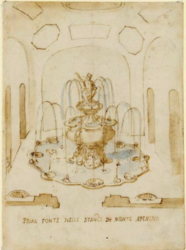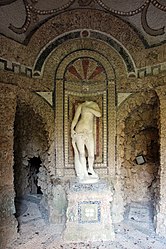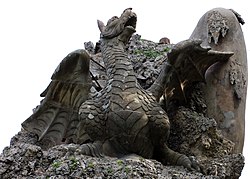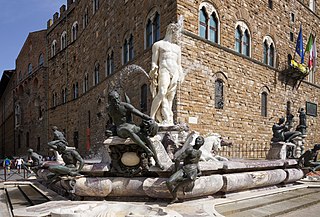
Bartolomeo Ammannati was an Italian architect and sculptor, born at Settignano, near Florence, Italy. He studied under Baccio Bandinelli and Jacopo Sansovino and closely imitated the style of Michelangelo.

Giambologna, also known as Jean de Boulogne (French), Jehan Boulongne (Flemish) and Giovanni da Bologna (Italian), was the last significant Italian Renaissance sculptor, with a large workshop producing large and small works in bronze and marble in a late Mannerist style.

Cosimo I de' Medici was the second Duke of Florence from 1537 until 1569, when he became the first Grand Duke of Tuscany, a title he held until his death.
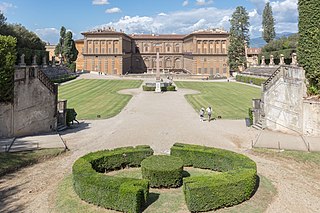
The Boboli Gardens is a historical park of the city of Florence that was opened to the public in 1766. Originally designed for the Medici, it represents one of the first and most important examples of the Italian garden, which later served as inspiration for many European courts. The large green area is a real open-air museum with statues of various styles and periods, ancient and Renaissance that are distributed throughout the garden. It also has large fountains and caves, among them the splendid Buontalenti grotto built by the artist, architect, and sculptor Bernardo Buontalenti between 1536 and 1608.

Gelato is the common word in Italian for all kinds of ice cream. In English, it specifically refers to a frozen dessert of Italian origin. Artisanal gelato in Italy generally contains 6%–9% butterfat, which is lower than other styles of frozen dessert. Gelato typically contains 35% air and more flavoring than other kinds of frozen desserts, giving it a density and richness that distinguishes it from other ice creams.

Bernardo Buontalenti, byname of Bernardo Delle Girandole, was an Italian stage designer, architect, theatrical designer, military engineer, artist, and inventor of Italian ice cream.

Piazza della Signoria is a w-shaped square in front of the Palazzo Vecchio in Florence, Italy. It was named after the Palazzo della Signoria, also called Palazzo Vecchio. It is the main point of the origin and history of the Florentine Republic and still maintains its reputation as the political focus of the city. It is the meeting place of Florentines as well as the numerous tourists, located near Palazzo Vecchio and Piazza del Duomo and gateway to Uffizi Gallery.

Jacopo Ligozzi (1547–1627) was an Italian painter, illustrator, designer, and miniaturist. His art can be categorized as late-Renaissance and Mannerist styles.

Pietro Tacca was an Italian sculptor, who was the chief pupil and follower of Giambologna. Tacca began in a Mannerist style and worked in the Baroque style during his maturity.

Niccolò di Raffaello di Niccolò dei Pericoli, called "Il Tribolo" was an Italian Mannerist artist in the service of Cosimo I de' Medici in his natal city of Florence.

Ferdinando de' Medici was the eldest son of Cosimo III de' Medici, Grand Duke of Tuscany, and Marguerite Louise d'Orléans. Ferdinando was heir to the Grand Duchy of Tuscany, with the title Grand Prince, from his father's accession in 1670 until his death in 1713. He is remembered today primarily as a patron of music. An excellent musician himself, he attracted top musicians to Florence and thus made it an important musical center. Through his patronage of Bartolomeo Cristofori, Ferdinando made possible the invention of the piano.

Pierre Franqueville, generally called Pietro Francavilla, was a Franco-Flemish sculptor trained in Florence, who provided sculpture for Italian and French patrons in the elegant Late Mannerist tradition established by Giambologna.

Tommaso Francini (1571–1651) and his younger brother Alessandro Francini were Florentine hydraulics engineers and garden designers. They worked for Francesco I de' Medici, Grand Duke of Tuscany, above all at the Villa Medicea di Pratolino, whose water features Francesco de Vieri described thus in 1586: "the statues there turn about, play music, jet streams of water, are so many and such stupendous artworks in hidden places, that one who saw them all together would be in ecstasies over them."

The Villa di Pratolino was a Renaissance patrician villa in Vaglia, Tuscany, Italy. It was mostly demolished in 1822. Its remains are now part of the Villa Demidoff, 12 km north of Florence, reached from the main road to Bologna.

The Villa di Castello, near the hills bordering Florence, Tuscany, central Italy, was the country residence of Cosimo I de' Medici, Grand Duke of Tuscany (1519-1574). The gardens, filled with fountains, statuary, and a grotto, became famous throughout Europe. The villa also housed some of the great art treasures of Florence, including Sandro Botticelli's Renaissance masterpieces The Birth of Venus and Primavera. The gardens of the Villa had a profound influence upon the design of the Italian Renaissance garden and the later French formal garden.

The Italian Renaissance garden was a new style of garden which emerged in the late 15th century at villas in Rome and Florence, inspired by classical ideals of order and beauty, and intended for the pleasure of the view of the garden and the landscape beyond, for contemplation, and for the enjoyment of the sights, sounds and smells of the garden itself.

The Tower or Torre dei Rossi-Cerchi is a reconstructed medieval tower, now part of the Hotel Pitti Palace al Ponte Vecchio, located on Via Guicciardini, corner Borgo San Jacopo, in the Oltrarno district near the entrance to the Ponte Vecchio in Florence, region of Tuscany, Italy.

The Fountain of Neptune in Florence, Italy, is situated in the Piazza della Signoria, in front of the Palazzo Vecchio. The fountain was commissioned by Cosimo I de' Medici in 1559 to celebrate the marriage of Francesco de' Medici I to Grand Duchess Joanna of Austria. Cosimo I de' Medici was the Duke of Florence from 1537-1569 and responsible for a vast number of architectural and artistic elements in Florence that still exist today.

Nano Morgante was an Italian dwarf who was a famed buffoon and court jester in the court of Cosimo I de' Medici, Grand Duke of Tuscany. Morgante was ironically nicknamed after the giant from the poem of the same name by Luigi Pulci. He was the most celebrated of the five dwarves of the Medici court at the Palazzo Pitti.
Rinaldo Barbetti was an Italian sculptor, designer and illustrator. He created designs with different art mediums such as leather, gold and wood.







